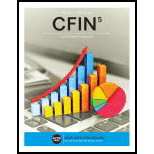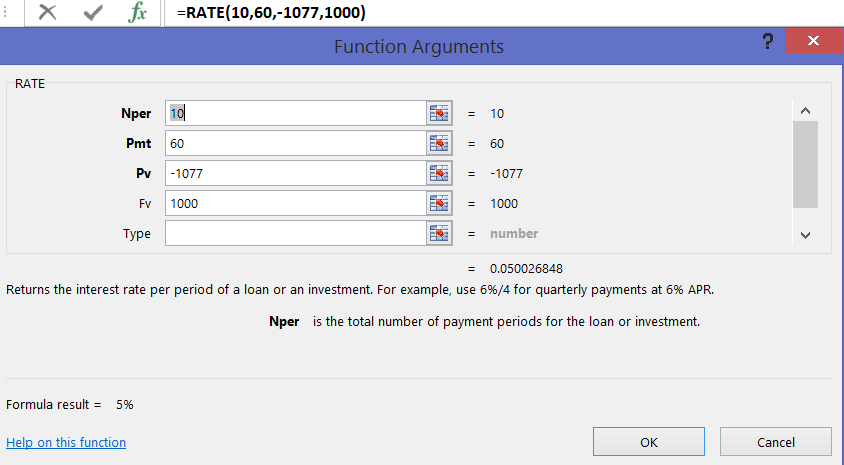
Concept explainers
YTM is the yield to maturity. It is the rate earned by the investor if he holds the bond till maturity.
Calculate the YTM by using the following formula:
Where,
M is the par value or face value,
INT is the dollar interest payment,
N is the number of years of interest payment.
After tax cost of debt: Interest expenses are tax deductible. So, after tax cost of debt is obtained after deducting the tax expenses from the cost of debt.
Calculate the after tax cost of debt by using the following formula:
T is the tax rate,
G products is plan to issue new bonds for new growth opportunity. Interest payment is $60, maturity 10 years, current price is $1,077 and tax rate is 40%
Explanation of Solution
a.
Calculate the YTM as follows:
Using Excel calculate YTM:

Therefore, the YTM is
a.
Calculate the after tax cost of debt as follows:
Therefore, the after tax cost of debt is
Want to see more full solutions like this?
Chapter 11 Solutions
CFIN (with Online, 1 term (6 months) Printed Access Card) (New, Engaging Titles from 4LTR Press)
- 1: ________ is shown on a multiple-step but not on a single-step income statement. A. Credited to Inventory B. A customer utilizes a prompt payment incentive. C. Debited to the Inventory account D. Gross profitarrow_forwardwhat is corporate finance? explain it.arrow_forwardA lorenz curve graphs the _________________ received by everyone up to a certain quintile. A. Unequal distribution over time B. Normative shares of income C. Cumulative shares of income D. Total share of incomearrow_forward
- Question 5 1 The common shares of Almond Beach Inc, have a beta of 0.75, offer a return of 9%, and have an historical standard deviation of return of 17%. Alternatively, the common shares of Palm Beach Inc. have a beta of 1.25, offer a return of 10%, and have an historical standard deviation of return of 13%. Both firms have a marginal tax rate of 37%. The risk-free rate of return is 3% and the expected rate of return on the market portfolio is 9½%%. 1. Which company would a well-diversified investor prefer to invest in? Explain why and show all calculations. 2. Which company Would an investor who can invest in the shares of only one firm prefer to invest in? Explain why. Use the following template to organize and present your results: Theoretical CAPM Actual offered Almond Beach Inc. Palm Beach Inc. prediction for expected return (%) return (%) Standard deviation of return (%) Beta Comments on the diversified investor's choice Comments on the individual investor's choicearrow_forwardsolve this question by using appropriate methodology and true answer.arrow_forwardSs stores question problem answer.arrow_forward
 Essentials Of InvestmentsFinanceISBN:9781260013924Author:Bodie, Zvi, Kane, Alex, MARCUS, Alan J.Publisher:Mcgraw-hill Education,
Essentials Of InvestmentsFinanceISBN:9781260013924Author:Bodie, Zvi, Kane, Alex, MARCUS, Alan J.Publisher:Mcgraw-hill Education,

 Foundations Of FinanceFinanceISBN:9780134897264Author:KEOWN, Arthur J., Martin, John D., PETTY, J. WilliamPublisher:Pearson,
Foundations Of FinanceFinanceISBN:9780134897264Author:KEOWN, Arthur J., Martin, John D., PETTY, J. WilliamPublisher:Pearson, Fundamentals of Financial Management (MindTap Cou...FinanceISBN:9781337395250Author:Eugene F. Brigham, Joel F. HoustonPublisher:Cengage Learning
Fundamentals of Financial Management (MindTap Cou...FinanceISBN:9781337395250Author:Eugene F. Brigham, Joel F. HoustonPublisher:Cengage Learning Corporate Finance (The Mcgraw-hill/Irwin Series i...FinanceISBN:9780077861759Author:Stephen A. Ross Franco Modigliani Professor of Financial Economics Professor, Randolph W Westerfield Robert R. Dockson Deans Chair in Bus. Admin., Jeffrey Jaffe, Bradford D Jordan ProfessorPublisher:McGraw-Hill Education
Corporate Finance (The Mcgraw-hill/Irwin Series i...FinanceISBN:9780077861759Author:Stephen A. Ross Franco Modigliani Professor of Financial Economics Professor, Randolph W Westerfield Robert R. Dockson Deans Chair in Bus. Admin., Jeffrey Jaffe, Bradford D Jordan ProfessorPublisher:McGraw-Hill Education





